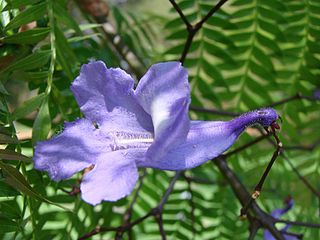
Saccharum is a genus of tall perennial plants of the broomsedge tribe within the grass family.

Xylosma is a genus of flowering plants in the family Salicaceae. It contains around 100 species of evergreen shrubs and trees commonly known as brushhollies, xylosmas, or, more ambiguously, "logwoods". The generic name is derived from the Greek words ξύλον (xylon), meaning "wood, tree", and ὀσμή (osmé), meaning "smell", referring to the fragrant wood of some of the species. The Takhtajan system places it in the family Flacourtiaceae, which is considered defunct by the Angiosperm Phylogeny Group.

The Rhamnaceae are a large family of flowering plants, mostly trees, shrubs, and some vines, commonly called the buckthorn family. Rhamnaceae is included in the order Rosales.

Moringa is the sole genus in the plant family Moringaceae. It contains 13 species, which occur in tropical and subtropical regions of Africa and Asia and that range in size from tiny herbs to massive trees. Moringa species grow quickly in many types of environments.

Jacaranda is a genus of 49 species of flowering plants in the family Bignoniaceae, native to tropical and subtropical regions of the Americas while cultivated around the world. The generic name is also used as the common name.

Plumeria, also known as frangipani, is a genus of flowering plants in the subfamily Rauvolfioideae, of the family Apocynaceae. Most species are deciduous shrubs or small trees. The species are native to the Neotropical realm, but are often grown as cosmopolitan ornamentals in tropical regions, especially in Hawaii, as well as hot desert climates in the Arabian Peninsula with proper irrigation.

Bombax is a genus of mainly tropical trees in the mallow family. They are native to western Africa, the Indian subcontinent, Southeast Asia, and the subtropical regions of East Asia and northern Australia. It is distinguished from the genus Ceiba, which has whiter flowers.

Urb was a monthly American magazine devoted to electronic music, hip hop and urban lifestyle and culture. Based in Los Angeles, California, the magazine was founded in 1990 by Raymond Roker.

Loasaceae is a family of 15–20 genera and about 200–260 species of flowering plants in the order Cornales, native to the Americas and Africa. Members of the family include annual, biennial and perennial herbaceous plants, and a few shrubs and small trees. Members of the subfamily Loasoideae are known to exhibit rapid thigmonastic stamen movement when pollinators are present.

Elekmania is a genus of the tribe Senecioneae and the family Asteraceae.
Cyclocarpa stellaris is a species of flowering plant in the legume family, Fabaceae. It is an annual or perennial herb or subshrub. It has a disjunct distribution, from Senegal to Tazania and Mozambique in sub-Saharan Africa, in Indochina, Peninsular Malaysia, Borneo, and Java, and in western and northern Australia. It is the only member of the genus Cyclocarpa.

Piscidia is a genus of flowering plants in subfamily Faboideae of the family Fabaceae. It includes seven species of trees, and rarely shrubs, native to the tropical Americas, ranging from northern Mexico and Florida through Central America and the Caribbean to Venezuela and Peru. Typical habitats include seasonally-dry tropical forest, woodland, and bushland, often on rocky hills, with some species restricted to limestone substrates.
Johann Maria Hildebrandt was a German explorer, collector, and scientist.

Metopium or poisonwood is a genus of flowering plants in the sumac family, Anacardiaceae. They are dioecious trees with poisonous sap that can induce contact dermatitis.

Elaeodendron is a genus of flowering plants in the staff vine family, Celastraceae. It includes 39 species native to the tropics of the Americas, sub-Saharan Africa, Asia, Australia, and the South Pacific.

Newtonia hildebrandtii, the Lebombo wattle, is a medium-sized tree native to eastern Africa. It is a protected tree in South Africa.

Encephalartos hildebrandtii is a species of cycad in the Zamiaceae family. It is native to Kenya and Tanzania at elevations from sea level to 600 metres (2,000 ft). The species is named for the German explorer Johann Maria Hildebrandt.

Streptopetalum is a genus of flowering plants belonging to the family Passifloraceae.
Tricliceras brevicaule is a perennial herb native to Africa. There are two varieties of T. brevicaule:brevicaule and rosulatum. The varieties can be identified by the shape of their petals. Variety brevicaule has petals with pointed ends, while rosulatum has rounded ends. T. brevicaule var. brevicaule can be found in bushlands and grasslands of Kenya, Tanzania, Mozambique and Zambia. T. brevicaule var. rosulatum can be found in the forests, woodlands, and roadsides of Kenya, Tanzania, Malawi, Mozambique and Zambia.
Streptopetalum graminifolium is a subshrub native to western Tanzania, Africa. It reaches heights of 0.4 meters, has 1.5 mm long leaves, and distylous racemose flowers.















